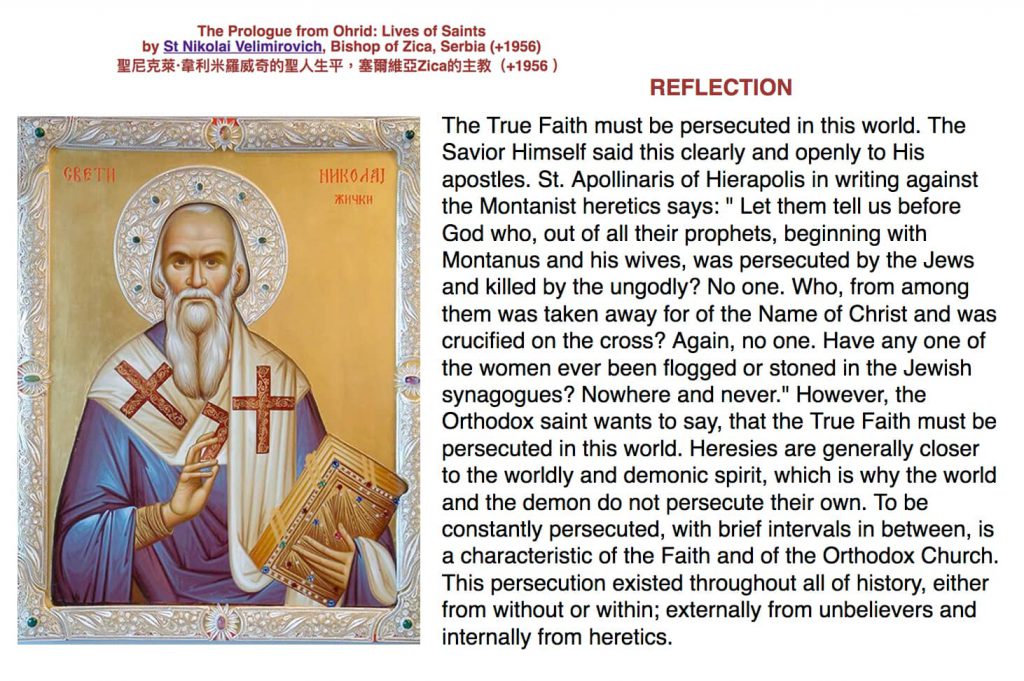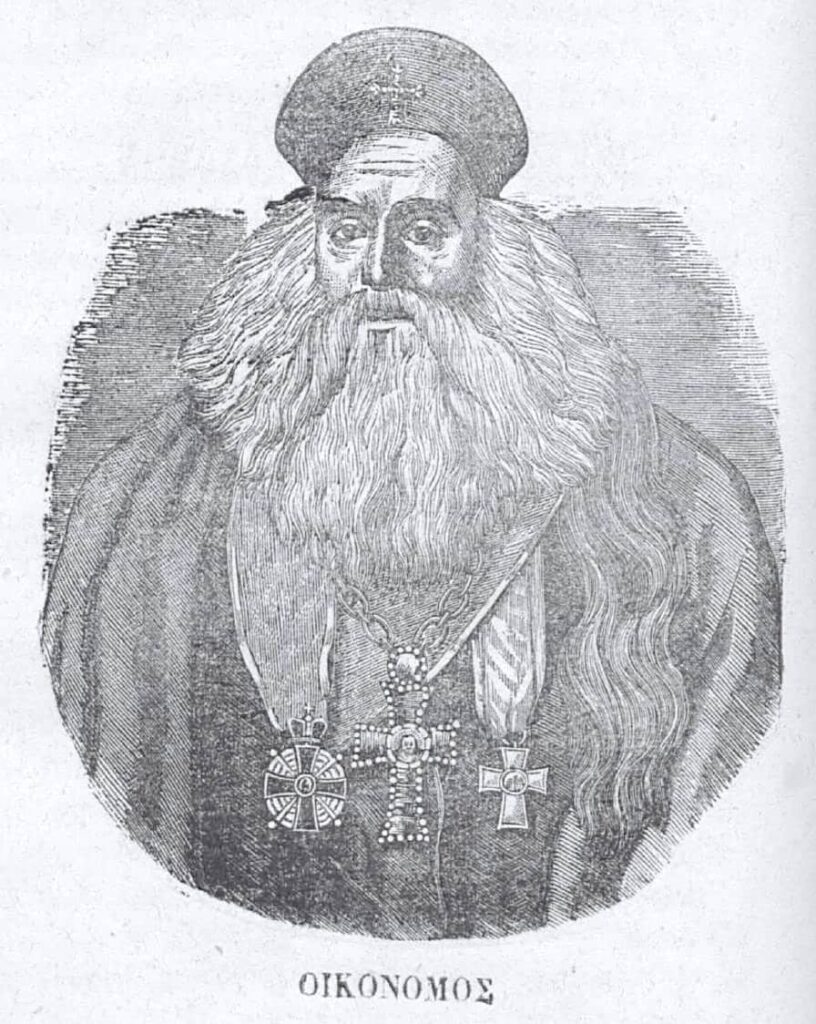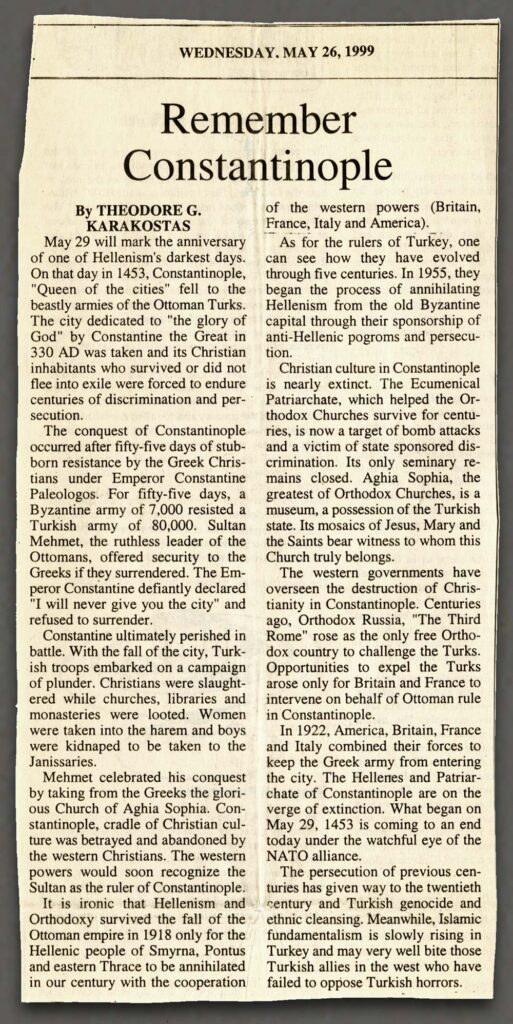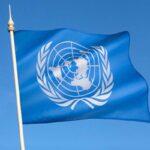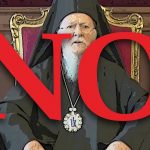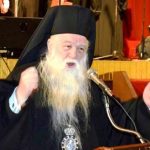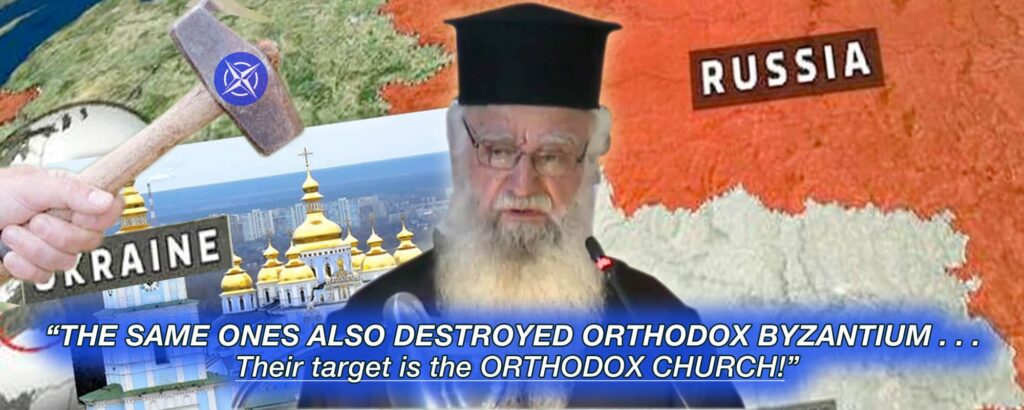
Western “Crusaders” against Orthodox Russia
Protopresbyter Theodore Zisis1 is Emeritus of the Theological School of the Aristotelian University of Thessaloniki. He was defrocked by the Ecumenical Patriarchate and received by the Church of Greece as an unpaid cleric. He has stated that he is considered by some “an unruly and rebellious clergyman”, and that he was defrocked because of his austere criticism of the “shameful and treacherous text” produced at Balamand (Lebanon, 1993), where he was a representative of the Orthodox Church in dialogue with the Roman Catholics. Read more about Fr. Theodore (in Greek).
- The example of Orthodox Serbia. Kosovo and Ukraine.
- Russian Odessa receives and honors the remains of the hieromartyr patriarch Gregory V
- The target of the western Crusaders, old and new, is the Orthodox Church. What Saint Nektarios says.
- The Romanization of Byzantium was weakened. Orthodox Russia was strengthened.
- Constantinople: Ally of the West and pioneer in cooperating with the Papists and Protestants
1. The example of Orthodox Serbia. Kosovo and Ukraine.
All those who who have no historical background and are following what is happening these days on the border of Ukraine, in the conflict between the western alliance of NATO and Russia, where the “new Crusaders” are aiming to detach Ukraine from its historical and geopolitical connection with Russia and to join it with the Western alliance of the Franco-Latin, papal and Protestant West, cannot understand the justifiably the strong reaction of Russia and probably justify not Russia to defend itself, but justify the attacking new Crusaders of the West.
Once again, they are taking up arms to achieve whatever they did in their drawn out war against Orthodox Serbia after the break-up of Yugoslavia. After the intervention of the Pope [John Paul VI] and the local wars, the independent “Catholic” states of Croatia and Slovenia were established with territorial arrangements at the expense of Orthodox Serbia. NATO itself intervened in 1999 (March-June) and with a relentless, murderous bombardment against Serbia which lasted for months, they disbanded its military force and forced them to withdraw from the historic cradle of their civilization, Kosovo, which they handed over to Muslim Kosovar Albanians, filling the Balkans with new independent Franco-Latin protectorates, Euro-American, papist and Muslim, who encircled Orthodox Serbia, but also wavered between Eastern and Western Greece. The latter, as a member of NATO, facilitated the military operations, however the conscience of the people sided with defending Orthodox Serbs.
The Vatican’s incitement to the ambassadors of western countries by the mouth of Polish pope Paul VI himself, was indelibly recorded by a Greek member of the European Parliament:
“Arm the Muslims and disarm the Serbs.”
Just as Kosovo is the cradle of civilization, both national and Christian, for the Serbs, so also is Kiev in Ukraine for the Russians. Kiev was the first capital of Russia and was where their Baptism, their Christianization took place (988 AD), and from there, centuries onward, Russian Orthodoxy, Russian culture developed, with glorious temples, renowned monasteries, and great ascetic Saints.
Even after the conquest of their territory by the Mongols in 1240 AD and the transfer of the capital, first to Vladimir and finally to Moscow, Kiev was still considered Russian territory and was claimed by the Russians. After the Mongols, the region was conquered by the Poles, and for two centuries until 1654 AD, after the victory of the Russians over the Poles, the parenthesis of the Polish conquest of their territories was closed and the unity of Moscow and Kiev was restored.
Throughout the Polish conquest, and in part of the Lithuanian conquest in some Russian territories, Kiev became the center of activity for the Jesuits and the Uniates, where, along with the latinization of the Orthodox and their ecclesiastical independence from Russia with the creation of a separate Kieven Metropolis, a systematic attempt of ethnic detachment was undertaken with the cultivation of a Ukrainian consciousness, Ukrainianism, and the systematic development of Russophobia.
Nowhere in the annals of Greek history is the word “Ukraine” found, but rather, the Russian nation is presented universally by geographical population characteristics, such as Greater Russia, Little Russia, White Russia. Today’s Ukraine is Little Russia, Moscow is Greater Russia and Belarus is White Russia. What is happening today in Ukraine with the growing Russophobia and the attempt at Westernization has its roots back in history in the attempts to polarize and latinize the inhabitants.2
2. Russian Odessa receives and honors the remains of the hieromartyr patriarch Gregory V
It is worth mentioning, in the context of celebrating the 200-year anniversary of the 1821 revolution [2021 AD], the glorious reception given by Russia, by both Church and State, of the body of hieromartyr Patriarch Gregory V, in June 1821 in the city of Odessa, in Russian Odessa, because at that time there was no Ukraine. After the miraculous recovery of his relics from the sunken “Bridge of Galatia” ship of Ioannis Sklávos, a captain from Cephalonia, his relics were transported under a Russian flag to Odessa where they were buried with imperial honors.
G. Papadopoulos in his book, History of Gregory V, Patriarch of Constantinople, Champion of the Greek Revolution, when mentioning preparations for the patriarch’s funeral, says that the general ordinance for the order had Russian commander Count Alexander Theodorides Lanzheron, Commander General of Little Russia, venerate the holy incorrupt relics first, and then the clergy. For over three days “a great multitude of people, all very reverently, flowed into the church from the nearest provinces of Little Russia.”3
In the eulogy which was delivered by the great teacher of the Greek nation, Constantine Economos in Odessa on June 19, 1821 at the Russian Cathedral of the Transfiguration of the Savior, among other things, addressed the following to the late patriarch:
“Although Your full holy Synod is not surrounding your person, but surrounds your relics as to a trunk of a palm tree, respected Shepherds and priests on behalf of the most holy Synod of the Russian Church, although you have not been buried by now in high honors in the land of Greece not groaning, but are being buried with high honors in a free land, and are honored luminously by both your compatriots here present and by the brave and God-fearing Russians, of the kind who are reverent in faith, together with their victorious mighty Greek fighters whom she has found to honor and to publicly defend divine and human rights.” 4
So then, in Russian Odessa, not Ukrainian, was the hieromartyr and ethnarch patriarch Gregory V buried, by Russian hierarchs and priests, Orthodox believers with the Synod of the Russian Church, in Little Russia, today’s Ukraine, and it was not some pseudo-autocephalous Ukrainian church which honored and glorified the earthen abode of the heroic patriarch.
A return of thanks and gratitude was made by the Greeks to Orthodox Russia and the Russian Church with festal, laudable eulogies on the occasion of the 50th anniversary of the 1821 revolution in 1871, when the translation of the patriarch’s relics from Odessa to their deposition in the metropolis church in Athens took place.
From the multitude of relevant references we will only relate what the poet Aristotle Valaoritis writes in the Prologue of the shocking poem “Statue” which he recited the following year on March 25, 1872, in front of the statue that had been prepared. It begins with the verses:
How do you gaze on us motionless?…
To where does your mind run?
He writes in the Prologue among other things:
The holy relics of the great ethnomartyr of Greece remains three whole days hung upon the gallows, but then handed over to the maniacal mob of people and slandered on every street and alleyway of Byzantium, as someone mortally unworthy of burial, and was cast into the depths of the Bosphorus.
But God Most-high took it from the belly of the sea and entrusted it into the hands of Orthodox Russia, which returned him imperial honor and a service commensurate to the monstrous enormity of the cruel crime perpetrated and the high cost, which was held for the executed patriarch amid the full assembly of the Church.”5
3. The target of the western Crusaders, old and new, is the Orthodox Church. What Saint Nektarios says.
We opened a parenthesis about patriarch Gregory V to show, as an example, that in the historical consciousness of Greeks and Russians, Kiev, Odessa, and all the southern shores of the Pontian Black Sea have historically been considered Russian territory, and just as the Crusaders of NATO fought against Orthodox Serbia in the 1990s, as they did in the past with the Polish and Lithuanian conquests of the territories of Little Russia (Ukraine), so they are also doing today with their attempt to delimit Ukraine from Russia, politically and ecclesiastically, and join them to the western landscape.
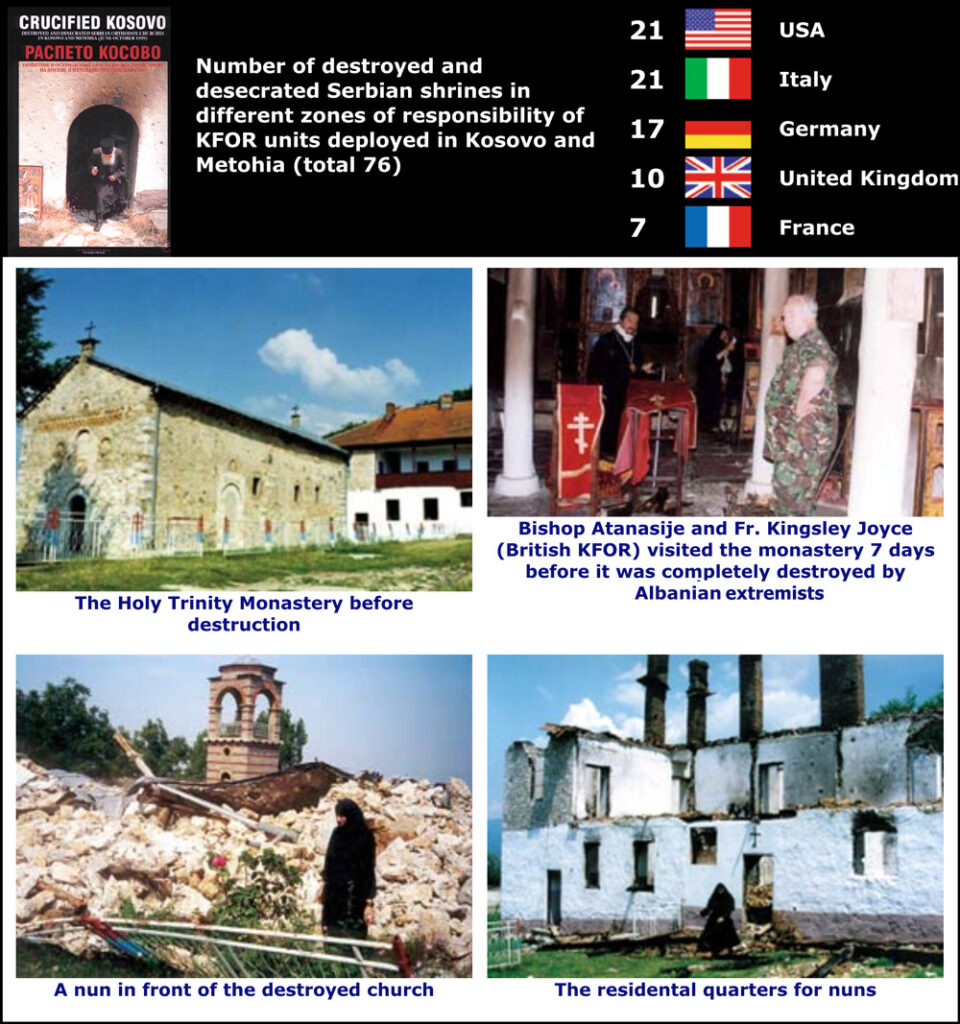
Political independence was certainly achieved after the dissolution of the Soviet Union in 1990, however the cultural connection of the two brotherly peoples continued, and continues, as does the ecclesiastical attachment to the Russian Church which patriarch Bartholomew tragically worked against, by his collaborating with the western Crusaders who dissolved Byzantium and profaned Constantinople in 1204 AD, essentially collaborating against the Orthodox Church.
The aim of the heretical West, incited by the Devil, is to, in time, dismantle the Orthodox Church, that is, the One, Holy, Catholic and Apostolic Church, and to de-Christianize the Orthodox East, as it has already de-Christianized itself. This demonic crusading behavior goes very far back, to the conquest of Constantinople by the Pope’s Crusaders in 1204 AD, which, according to respected historians, weakened the then planetary Greek empire, and after sixty years of slavery to the Franco-Latins, they returned only to be subjected under the Turkish yoke in 1453 AD, to the great joy of the West, who had filled the Greek land with Franco-Latin states and had encircled Constantinople, as they are encircling Moscow today. They thought they would extinguish the flame of Orthodox culture and leave only the materialistic, rationalistic, and distorted western culture, which is no way Christian.
I will not quote historical accounts from the many which exist, about the barbarity and pillaging, about the hatred of the Crusaders against the Orthodox of Constantinople. I will only mention what Saint Nektarios says, things that are not well known, and from these, two other interesting aspects about the present-day ecclesiastical reality emerge.
At the outset, the claim by ecumenist clergy and theologians is squashed, that Saint Nektarios was a Pope sympathizer. He also shows the age-old hypocrisy of the papacy and the worldly diplomatic discourse, which, on the one hand seeks to apologize for as much suffering they have brought upon the Orthodox people, while on the other hand encourages and blesses the wars and attacks against Orthodox people.
It is obvious who the Vatican supports today in the confrontation in Ukraine between the West and Russia: the United States and NATO (as they did also in the 1990’s in Serbia, supporting the “Catholic” states on the borders of Russia, the Uniates) and the Ukrainian schismatics, and not the right of Orthodox Russia to defend itself from those who are encircling.
The popular and gentle Saint Nektarios of Aegina, among the most eminent Saints of the 20th century, writes:
“The hatred of the Greeks by the Western church inspired the entire West to make the ignorant peoples of the West fanatical enemies of the Greeks, whom they considered heretical enemies. These Latin leaders, of whom the populace was ignorant, believed every profane slander and calumny against the Greeks by the organs of the Papal see, and they accepted as undisputed truth everything that these clergymen said about the privileges of the Roman See, and about the heretical dystopia of the Greeks.
The Crusaders, an ignorant and fanatical mob, fed half as much to the Greeks as they did to the Ottomans. The fall of Constantinople under the Crusaders, the wild Vandals of the West, sealed the schism. The Crusaders, by their actions and deeds, showed that Western Christianity was a monster, while Pope Innocent III testified that he was not their true shepherd and guide.
In the meantime, the Pope wrote a letter to the Crusaders, in which he views them as instruments of divine will, and in the first half of the letter he seems to shame them for the horrible evils, whatever was done against the Greeks, ‘whom they loathed as dogs’, and in remainder he blesses their work, considering it a work of divine will.
Innocent also wrote an encyclical to the Church of the West saying that the Lord wanted to comfort his Church through the union of the schismatics, remove the Empire from the arrogant and superstitious and disobedient Greeks, and to give her to the humble, reverent, orthodox, and obedient Latins!
How truly wonderful the infallible Pope appears, with his reliable point of view concerning the will of the Lord! But not every Pope is so admirable.” 6
4. The Romanization of Byzantium was weakened. Orthodox Russia was strengthened.
From the 7th century, the violent, aggressive, antichrists of Islam took away vital land from the world-renowned Greek empire of Byzantium in Asia and Africa, however, as a counterbalance to their territorial losses, God foreordained to raise up Orthodoxy in the Balkans and in the North for the Slavic peoples, among whom Holy and Great Russia glorified Orthodoxy and was glorified by it.
It is certainly divine regulation that shortly before the breakaway of Papism from the One, Holy, Catholic and Apostolic Church at the beginning of the second millennium, in 1054 AD, when the efforts of the West began to destroy Orthodoxy with the Crusades and the Uniates, Constantinople had acquired a strong Orthodox ally – the Russians – to whom it transmitted the Orthodox Faith, assuming, moreover, centuries of devotion, support and protection, in the face of the Franks of the Pope, but also in the face of the new strong Islam of the Ottoman Turks, to whom they were subjected after the tragic fall of Constantinople in 1453 AD.
Just as Constantinople was a splinter in the eye of the West, and did everything in order to destroy her either by deeds (the crusades) or by omissions (they did not send aid to the Turks), the same happened to the powerful Orthodox Russia of the Tsars, with Holy Russia of the pre-Communist years. As a strong protector of Orthodox peoples, it constituted an unassailable wall of security against the “Holy Alliances” of the West, which eyed the East for economic and cultural reasons.
The conscience of the enslaved Greeks under Turkish rule, who expected the “blonde race”, the Muschovites, to come and take back Hagia Sophia, was strengthened with important actions taken by Russia, militarily and politically. If it was sometimes let down, it showed over the provisions. In any of the selfish pursuits of the West toward the resolution of the infamous “Eastern Question”, that is, about the partitioning and distribution of the Ottoman Empire, a counterbalance was the might of Οrthodox Russia.
The subjugation of Russia with a war was certainly shown to be unattainable, from the example of Napoleon and later of Hitler. However, the post-Soviet was utterly weak with the break up of the Soviet Union and the dearth of strong leaders, which resulted in the cessation of the diarchy, the polarity between America and Russia during the Cold War, which resulted in only America ruling and dominanting in the world. This is also why the crusaders of NATO dared the unprovoked and needless war against Orthodox Serbia.
However, because the head of the Church and ruler of the world is Christ, not the pope, nor Washington and Berlin, He directs the course of history and the world, Christianity in the West, and now in “Orthodox” Greece, which finds itself at a tragic impasse. Europe is being de-Christianized and converted to Islam; frightful pedophile scandals are shaking the rotted foundations of the papal clergy, whose bishops who do not believe in Holy Scripture and deny the Resurrection of Christ; homosexuality is justified and homosexual marriages are blessed; feminist insolence and arrogance repeat the sin of Eve; the family is broken up, the university is spoken ill of, civil marriage and civil divorce prevail; adultery is decriminalized; sex education is introduced at school in the first grade; pansexualism triumphs; the clergy have been secularized and adapt to what the sinful world desires; pan-religion and Ecumenism are already the customary expression of the Christian faith; and many regions of Europe are converting to Islam, with thousands of mosques going up and piercing the air of formerly Christian Europe.
The Orthodox East which was crucified, and is being crucified by the western Crusaders, endured and continues to endure. It did not convert to Islam, not even with the violence of the Muslim conquerors and became, over the centuries, the breakwater and stronghold of the senseless West.
Now that the atheistic storm of Communism has passed, Orthodox Russia is rebuilding and growing stronger under worthy and capable political leadership. It legislates and organizes social life with Christian and Orthodox values. The Crusaders of the West threaten, thinking they will succeed as much as they succeeded with Constantinople in the past, and with Serbia in recent years.
We did not expect, as all Orthodox not seduced by ethnoracial criteria, that what the West did not achieve throughout the entire second millennium, to break through and divide the Orthodox, would be achieved at the end of the millennium and the beginning of the third millennium: the instigation of a rivalry and conflict between their two powerful centers, the historic Constantinople, now weakened politically and ecclesiastically, and powerful cosmopolitan Moscow, which the West underestimates, envies, fights, and seeks in every way to humiliate in whatever way it can, as they succeeded in doing with the old empire of the Bosphorus.
5. Constantinople: Ally of the West and pioneer in cooperating with the Papists and Protestants
The politically and ecclesiastically weak Constantinople, especially after the Asia Minor Catastrophe and the stripping of its population (1922), was persuaded to be healed by turning exclusively and admirably to the West, which mortally embraced the Ecumenical Patriarchate, and changed it into a tool of the geopolitical architects, a captive of the Vatican and the World Council of Churches (WCC), and the diplomatic methods of America and Europe.
One article cannot possibly encapsulate this new, extremely dangerous reality for the unity of Orthodoxy, for the unity of the One, Holy, Catholic and Apostolic Church, as was seen clearly in the pseudo-synod of Kolymbari, Crete (2016) (which was organized and conducted under American supervision), and in the American-instigated, methodical ushering of the schismatics of Ukraine to pseudo-autocephaly (2018), interfering in the canonical jurisdiction of the Church of Russia and ignoring the local canonical Church of Ukraine, under Metropolitan Onuphry.
We will cite as many as three young researchers who have credentials, for those who are interested in more data. In the academically audited and approved doctoral dissertation entitled, “The Ecumenical Patriarchate in the throes of the Cold War: The election of Patriarch Athenagoras (1948)”, Paul Seraphim, after studying anecdotal archival material of the diplomatic and ecclesiastical archives of the USA, Great Britain, Greece and Turkey proves that the election of Athenagoras was the result of outside intervention on the part of the West, and certainly of the USA.
As Ilias Kouskouvelis, professor of International Relations and former dean of the University of Macedonia in Thessaloniki, writes in the preface of the book, the election of Athenagoras
“was the result of outside interventions on the part of the West, and, we see, of the United States. This was the first time that the United States not only dealt at the highest level with what is happening in an Orthodox land, but decisively interfered in order to ensure the pro-Western orientation of the Ecumenical Patriarchate.” 7
The author of the dissertation also writes:
“It was of vital importance for the United States that the Ecumenical Patriarchate remain in their sphere of influence, or at least not let them pass to the enemy. We must consider, in this context, how it was beneficial and also feasible at the same time for a patriarch to remain on the Ecumenical Throne, in order for him to be subjected, and suggesting that there was friendly relations toward the Russians, and, correspondingly, how sensible it would be to elevate a cleric to patriarch whom the Americans would have known well, with no doubt about his ideological orientation toward the West.” 8
The monk Seraphim Zisis, someone well acquainted with geopolitical developments, and moreso of ecclesiastical history and ecclesiology, in an article entitled “Patriarch Athenagoras, US policy and today’s Ukraine”, writes conclusively in the Epilogue:
“The elevation to the Throne by the documented Mason, Patriarch Athenagoras I (1948-1972), as it has been proven today by formerly classified documents of the US State Department, was the most characteristic case (although not the last) for the enslavement of ecclesiastical polity of the Ecumenical Patriarchate to the geopolitical designs of the USA, with the aim of limiting Russian influence. Unfortunately, this halt was not only to atheistic, Soviet Russia, but is also directed against Orthodox Russia today, simply because it is strongly opposed to the decadence of Western civilization and the geopolitical strength of the Western Alliance.” 9
Charalambos Mináoglou, a renowned historian who has made serious scientific contributions to the history of Hellenism and Orthodoxy, in a study, a presentation entitled, “The Phanar as Pioneer of American Politics: The geopolitical consequences of the Ukrainian schism” writes,
“In order not to hide behind our finger, the USA, those who rejoice very much over the dividing of Orthodox people in general, as well as the division of the Orthodox people in Ukraine, hope that the strengthening of the schismatic church over the canonical church, will help cultivate an anti-Russian mentality there, together with the mercenary organs of the American secret services and the various NGOs. No matter how you think about it, one cannot find any other reason behind this action of giving the schismatics autocephaly other than to serve ill-intented American interests. NATO, the great hegemony to which Greece has also submitted, wants to divide the Orthodox world as much as possible in order to weaken the only force that can challenge its sovereignty – Russia.” 10
The same author posted an article on the internet entitled, “What is happening in Ukraine? Who is to blame? What is Greece’s interest?” In a postscript to the article, referring to the ecclesiastical dimension of the Ukrainian question, he writes with bitter irony:
“If, at any rate, we [Greece] are obliged to send some troops, even a few, to fight Russia as part of our obligations as members of NATO, we could send the Russian-eating Greek-speaking archbishops, those who, led by the Ecumenical Patriarch, anathematize Russia with their ecclesiastical policy every day, and who with their war on the Russians have, so far, lost half of Africa, while at the same time have completely cut themselves off from the more than 200 million Slavic Orthodox Christians.” 11
- Cf. Protopresbyter Theodoros Zisis, “In Serbia they kicked Orthodoxy”, Theodromia 1 (1999) 115-117. See also our series of three articles entitled “Apology for the old ‘Crusades’; The new ones are better”, Theodromia 2 (2000) issue 5, pp. 5-9, issue 7, pp. 3-12, issue 8, pp. 3-14.
- More on Protopresbyter Theodore Zisis, The Ukrainian Autocephaly. Irregular and divisive invasion of Constantinople, Thessaloniki 2018, To Palimpsiston Publications, pp. 78-79. Also, Nikolai Selichev, “The historical roots of the ‘Orange Revolution’ in Ukraine”, Theodromia 8 (2006) 279-298.
- Anthology of those who have written about Patriarch Gregory V, from the most important of our compilations in our book, Patriarch Gregory V in the consciousness of the People, Kyriakidis Brothers Publishing House, Thessaloniki, 1986, pp. 99-101.
- ibid, p. 105.
- ibid, pp. 200-201.
- [Saint] Nectarios, Metropolitan of Pentapolis, A Historical study on the causes of the Schism, Vol I, Athens, 1911; volume II, Athens, 1912, pp. 96-98.
- Paul Seraphim, The Ecumenical Patriarchate at the height of the Cold War: The election of Patriarch Athenagoras (1948), Barbounaki Publications, Thessaloniki, 2017, p. 13.
- ibid, p. 71.
- Monk Seraphim Zisis, “Patriarch Athenagoras I: US policy and today’s Ukraine”, Theodromia 20, 2018, 454-499, pp. 495-496. For similar reports, see an article by the same author, “The intra-Trinitarian Monarchy of Patras and the new Monarch of Phanariotic ecclesiology”, Theodromia 21 (2019) 313-368.
- Charalambos Minaoglou, (Ph.D., History), “The Phanar as a pawn of American Politics: The geopolitical consequences of the Ukrainian Schism”, Theodromia 21 (2019) 369-377, pp. 371-372. The articles - presentations of the monk Seraphim Zisis and Charalambos Minaoglou were announced as presentations at a Conference at the University of Thessaloniki (Saturday, June 22, 2019), which had as its general theme, “Ukrainian Autocephaly and the New Ecclesiology of the Phanar”, where the minutes of the Conference were published in a double issue of Theodromia 21 (2019) 161-382.
- Charalambos Minaoglou, “What is happening in Ukraine? Who is to blame? What is Greece’s interest?”, Pentapostagma.gr. Opinions 26.01.2022.
Translated and illustrated by Anthony Hatzidakis, Feb. 8, 2024
The original Greek can be read on Aktines, “Δυτικοί ‘Σταυροφόροι’ εναντίον της Ορθόδοξης Ρωσίας”
